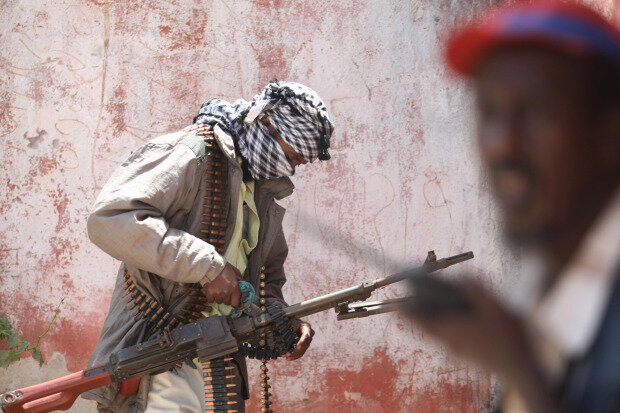Why Is the U.S. Sending Somalia Cash in a Bag?

Late in May, as violence consumed the streets of the infamously violent capital city of Mogadishu, Somalia, packages of ammunition, weapons, and cash began arriving from the United States as part of an attempt to help the country’s flailing Transitional Federal Government (TFG) stave off collapse. At the time, the Somali government was literally about to fail, reportedly controlling no more than a neighborhood in Mogadishu thanks to a fresh assault by two Islamist insurgent groups: al-Shabab and Hizbul Islam.
The contents of those shipments, not previously reported, included 19 tons of ammunition, 48 rifle-propelled grenades, 36 PKM machine guns (a model of the Russian-made Kalashnikov), 12 DShK machine guns (Russian-made anti-aircraft weapons, mostly used in Somali technicals), and 10 mortars (the firing apparatus for shells). The shipment was detailed in a letter from a U.S. official to the U.N. Security Council committee set up to oversee the 17-year-old arms embargo on Somalia. The U.S. official, Alejandro D. Wolff, deputy permanent U.S. representative to the United Nations, requested an exemption to the embargo, which was put in place in 1992 at the onset of civil conflict. In a second letter to the Security Council, Wolff explained that $2 million was also being sent to the Somali government “for the immediate procurement of equipment (weapons and ammunition) and logistics support (food, fuel, water, engineering services).”
All told, a State Department official admitted at a June 26 news briefing that it shipped “in the neighborhood of 40 tons worth of arms and munitions” to Somalia. “We have also asked the two units that are there, particularly the Ugandans, to provide weapons to the TFG, and we have backfilled the Ugandans for what they have provided to the TFG government,” the official told journalists. The cost was “under $10 million.” A different State Department official working on Somalia counterterrorism policy told Foreign Policy that of the total amount, the bulk was spent on ammunition, while the air freight bill was $900,000 and $1.25 million was “cash in a brown paper bag.”
The letters from Wolff explain that the cash was to be transferred to Nairobi, Kenya, and then moved by air to Mogadishu. The money was intended to be spent locally to buy arms, ammunition, and other supplies. (In recent years, AK-47s have sold on the streets of Mogadishu for anywhere from $100 to $600, depending on how heavy the fighting is at the time.) Meanwhile, ammunition was to be shipped to Somalia’s capital by air from Entebbe, Uganda. The transfer of the weapons is not described in the letters. However, a regional analyst, who was not authorized to speak on behalf of his affiliation, told FP that the shipments have been arriving in installments, doled out by the African Union peacekeepers who are guarding the Mogadishu airport.
The arms transfer was among the new U.S. administration’s first moves toward Somalia, a country that many see as a test case for President Barack Obama’s counterterrorism policy. The country has been in a state of war for nearly two decades, displacing a quarter of the country’s population, with half a million refugees scattered across the region and another 1.5 million displaced internally within Somalia. But in recent months, the East African country has become a growing concern for U.S. officials as local groups, most notably an Islamist faction named al-Shabab — some of whose leaders are thought to have been trained by al Qaeda — have expanded their control of the country.
At the time the arms were sent, the Transitional Federal Government was under a withering assault. “Somalia is in crisis,” Johnnie Carson, assistant secretary of state for African affairs, told the Senate Foreign Relations Committee on May 20, just days before the United States alerted the Security Council of its plan to send arms. “In the past two weeks, violent extremists, including al-Shabab and a loose coalition of forces under the banner of Hizbul al-Islam, have been attacking TFG forces and other moderates in Mogadishu in an attempt to forcefully overthrow the transitional government.”
According to experts on the region, the policy’s intent was both symbolic and tactical. “The symbolic [aspect] is a way of sending a message to Somalis that the United States is going to stand behind the TFG — that the United States will not allow it to fail and sees it as the only viable solution,” said Ken Menkhaus, a leading Somalia analyst, in an interview. Tactically, the intent was straightforward: to help the TFG fight back against its heavily armed opponents.
But there have been concerns about just how effective the arms shipments have been. On Aug. 11, Garowe, a Somali radio station and online news outlet, reported that arms transferred to the Somali government were being sold on the street. “When the U.S. made the decision in May, the Transitional Federal Government seemed to be hanging on by a thread. Initially, the declaration of support probably did have something to do with the TFG hanging on and pulling together,” the regional analyst told FP. “We didn’t see many leakages of weapons [at first] because they were too busy fighting. But what’s happened is that the consequences of that decision are still being felt. It now seems that the TFG forces have reached their capacity and can’t absorb much more in terms of arms and ammunition, so we’re starting to see and hear reports of leakages.”
To many observers, this seemed all too predictable. The small-arms trade has flourished for the 18 years that Somalia has been in conflict, with weapons proliferating dramatically despite the arms embargo. One of the most frequent channels has been through desertions; 14,000 of the TFG’s 17,000 forces deserted last year, many with their guns and uniforms. Today, desertions are less common thanks to a new, more popular president, according to the regional analyst. But he estimates that government forces, including police, only number about 5,000 — and that’s just on paper. In practice, the TFG forces are less a uniform force than a series of militias that operate independently, loyal to one government official or another. “When weapons are allocated to militias who are paid irregularly or not at all, a certain percentage will sell on the open market,” Menkhaus explained. “This is a common practice throughout the entire Horn of Africa.”
Regardless of whose hands the weapons are ultimately in, other analysts question the wisdom of sending more small arms to a country that is already all too rife with gunfire. The most recent report of the U.N. monitoring group for Somalia, published last December, includes an entire section naming the “unintended consequences of support to the security sector.” Among the concerns are the use of “heavy machine guns and rocket-propelled grenade launchers” by TFG police in an urban setting (where casualties are likely to be high). The report also details how captured TFG weapons, equipment, uniforms, and vehicles were “an important source of supply for armed opposition groups.”
The policy also raises questions about the broader U.S. stance toward Somalia. The State Department official working on Somalia counterterrorism policy told FP that “every element of the U.S. government seems to have its own piece of the Somalia plan.” There was no formal policy, he said, because of a disagreement about whether and how to support the Transitional Federal Government. “The Department of Defense thought they were just out of their minds [to send the arms shipment],” he said. “But since it was State’s money, the plan went through.” (Queried about this claim, Defense Department spokeswoman Almarah Belk responded via e-mail, “Policy toward Somalia is coordinated via the NSC [National Security Council]. DoD [Department of Defense] agrees and supports the DOS [Department of State] security assistance to the TFG.”)
There is also some question as to how popular the shipment was within the State Department itself. The State Department official told FP that there was no support and even active opposition to the plan among his colleagues. When a reporter at the June 26 briefing insinuated that the decision “was made at the highest level,” the briefing official replied that the policy was a “national decision” agreed upon by “the secretary and the NSC,” meaning Secretary of State Hillary Clinton and the National Security Council.
During her visit to Africa last month, Clinton vowed to “continue to provide equipment and training to the TFG as well as humanitarian assistance to the Somali people,” and wire service Agence France-Presse reported that the United States had plans to double its arms support from 40 tons to 80. (The doubling of arms support could not be confirmed as the State Department did not respond to queries a week after FP‘s first request.)
Nonetheless, some analysts who spoke to FP see a positive opening emerging in the war-wracked country. Somalia’s new president, Sheikh Sharif Sheikh Ahmed, who was inaugurated this spring, has garnered greater popular support for the Transitional Federal Government than at any time in the last two decades. And unlike the more than a dozen previously attempted government coalitions during that period, Sharif’s is the first not to be actively opposed by any of Somalia’s many clans. Al-Shabab, too, is losing popularity, some say. “Somalia now has at least the start of a government that is broadly representative of the Somali clan and societal landscape,” Carson said in his Senate testimony in May. “These are all significant steps forward for Somalia.”
__________
Source: Foreign Policy -
BY ELIZABETH DICKINSON
Comments
comments
 Calendar
Calendar






































